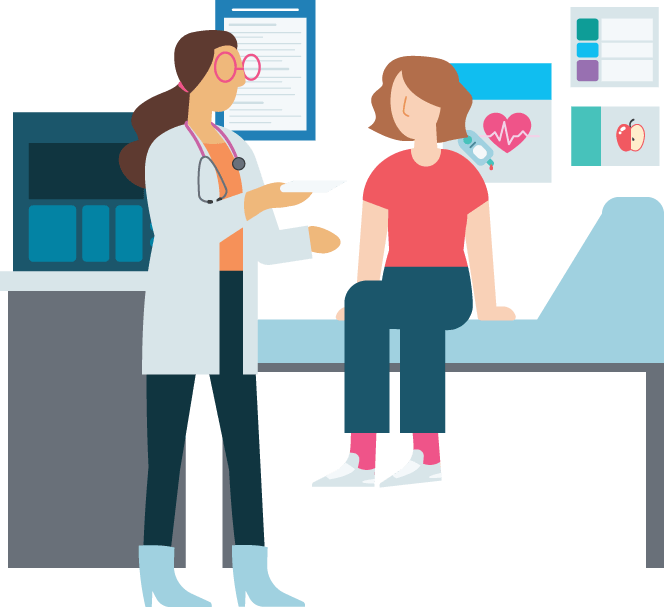Innovation in women’s health: Menopause and beyond
Women’s health is a complex field—and has inspired the founding of FemTech startups and other specialized services.
To better understand some of the recent developments in women’s health, Wellframe hosted a roundtable discussion with four subject matter experts from across the healthcare industry. Laurie McGraw, host of the “Inspiring Women” podcast hosted the discussion, which featured Sandhya Gardner, MD, Chief Medical Officer at HealthEdge, Deb Gordon, Forbes contributor and Founder of Umbra Health Advocacy, and Katie Schubert, President and CEO of The Society for Women’s Health Research.
What is women’s health?
The emergence of “women’s health” as a distinct area of healthcare is a relatively new development. It refers to a unique branch of medicine that includes health conditions that only affect women (and people with uteruses), like menstruation and pregnancy, as well as conditions affecting all genders but that impact women differently.
Frequently, women’s health issues are conflated with pregnancy and reproductive concerns. “But women experience health needs beyond that,” said Gordon. “Every aspect of our wellbeing should be part of women’s health.”
Women’s health is not a niche topic—it impacts roughly half the population. And our panelists agreed that the more focus and conversation there is around women’s health topics, the more opportunity there will be for innovation.

What are key areas of focus in women’s health right now?
Though women’s health encompasses all health and wellness needs a woman may have throughout her life, there are a few key areas that experts are leaning into first.
1. Overturning of Roe V. Wade
This June marked the one-year anniversary of the overturn of Roe v. Wade. The Supreme Court decision sparked widespread controversy as well as conversations about the importance of access to abortion and other pregnancy-related health services. For Dr. Sandhya Gardner, a former OB/GYN, one major concern is the impact on providers, and how effectively they can treat their patients.
There is a documented provider shortage in the U.S. already, especially among obstetricians and gynecologists. More than two-thirds of practicing OB/GYNs report that the new ruling worsened their ability to manage pregnancy-related health emergencies, as well as negatively impacting maternal mortality in the past year. Dr. Gardner points out that the continuing complexities surrounding maternal health could also make it more difficult to bring in new providers and maintain appropriate staffing levels—especially in states most heavily impacted by the decision.
For many women, this issue is more of an economic issue than a political one. They may not be able to afford to raise a child, and state restrictions make it more difficult to access and afford abortion services, leading to a cycle of worsening economic conditions. Women living in states with strict abortion laws are more likely to cite cost as a barrier to healthcare access, pay more out of pocket, be uninsured or underinsured, and report higher rates of maternal and infant mortality.
“Beyond abortion, it’s about access to OB-GYN care generally,” said Schubert, “Clinicians don’t want to work in states where they could be fined or arrested for providing care. States are losing economic productivity in addition to impacting public health.”

2. Underrepresentation in healthcare and research
To fully address the spectrum of women’s health needs, it’s important to shift our perspective of what “health” means. Until 1993, clinical trials were not required to include women. And there are still no requirements for including female mice in preclinical trials, meaning we are potentially decades behind in understanding how medical conditions present and progress differently based on gender.
One way to improve data collection and better understand women’s health issues is to leverage diagnosis codes. “Systemically, it is difficult to track the impacts of menopause because there wasn’t a diagnosis code for it,” said Schubert. A menopause ICD-10 code will roll out in 2024, but there won’t be enough data to analyze until at least 2025.
Outside clinical research, younger generations of women are having more open conversations about women’s health topics such as menstruation and menopause. “This has influenced a cultural shift where it’s not taboo to discuss periods and other women’s health experiences,” said Gordon. And as more Millennial and Gen Z women achieve leadership roles in the workplace, they’re making decisions based on their diverse lived experiences.
3. Emerging market opportunities
When it comes to health equity, women face greater economic barriers to care. A recent Deloitte study found that women spend $15 billion more on out-of-pocket expenses every year—even after excluding maternity-related services. But health plans and the healthcare industry can help close this gap and address the gender bias.
Digital tools and health apps can help support women’s health by giving them support outside of the doctor’s office. Health technology can come in the form of anything from period tracking apps to digital care management programs. What’s important is that these tools can give women the information they need to have more effective conversations with their providers. “These tools can put health information back in your hands and empower women to advocate for themselves,” said Schubert.
Though there has been a notable increase in the visibility and viability of FemTech companies, less than 3% of all venture capitalist funding is given to women-led startups. Investors are still predominantly male, potentially putting FemTech companies at a disadvantage. “Women’s health issues are unknown or taboo to a lot of male investors,” said Dr. Gardner, “So they don’t see the potential value in the product, or why these issues are so critical to solve.”
The increase in FemTech companies, female founders and investors in the industry are a step in the right direction—but it’s not moving quite fast enough. Gordon suggests talking to male colleagues and friends about the realities of women’s health to help normalize their experiences. She also advocates for women to leverage their collective purchasing power by “spending money on what we care about” and make a bigger impact.

How do you see the field of women’s health developing in the next 5-10 years?
It seems impossible to talk about the future of healthcare without talking about AI. For our experts, artificial intelligence (AI) has many potential applications across the field of women’s health. Digital health solutions are already using AI elements to help clinicians prioritize outreach, improving member engagement and outcomes in areas like maternal health. But that’s not all.
“We can leverage AI for everything from analyzing viable embryos to understanding what an individual woman’s menopause treatment might look like,” said Dr. Gardner. “There is so much possibility, but we’re not where we need to be.”
In addition to menopause, both Gordon and Schubert highlighted the increasing need among women for mental health services. From 2020 to 2022, 50% of women reported needing mental health services compared to 35% of men. Of that 50%, only half tried and were able to make an appointment for mental health care. Digital health solutions can help improve the quality and accessibility of mental health care, as well as facilitate informed conversations between members and clinicians.
There are areas of great opportunity within the field of women’s health, and many center on “leveraging technology to make clinicians more efficient and help them listen to patients better,” said Gordon.
“I’d love to see a world where we’re not just said to be equal, but it’s being demonstrated,” said Dr. Gardner. “Where we’re not talking about ‘women’s health,’ it’s just ‘health.”

Do you want more information about the ways your health plan can leverage digital solutions to improve member engagement and outcomes?
Watch our on-demand webinar, “How to support members and cut costs through digital engagement.”